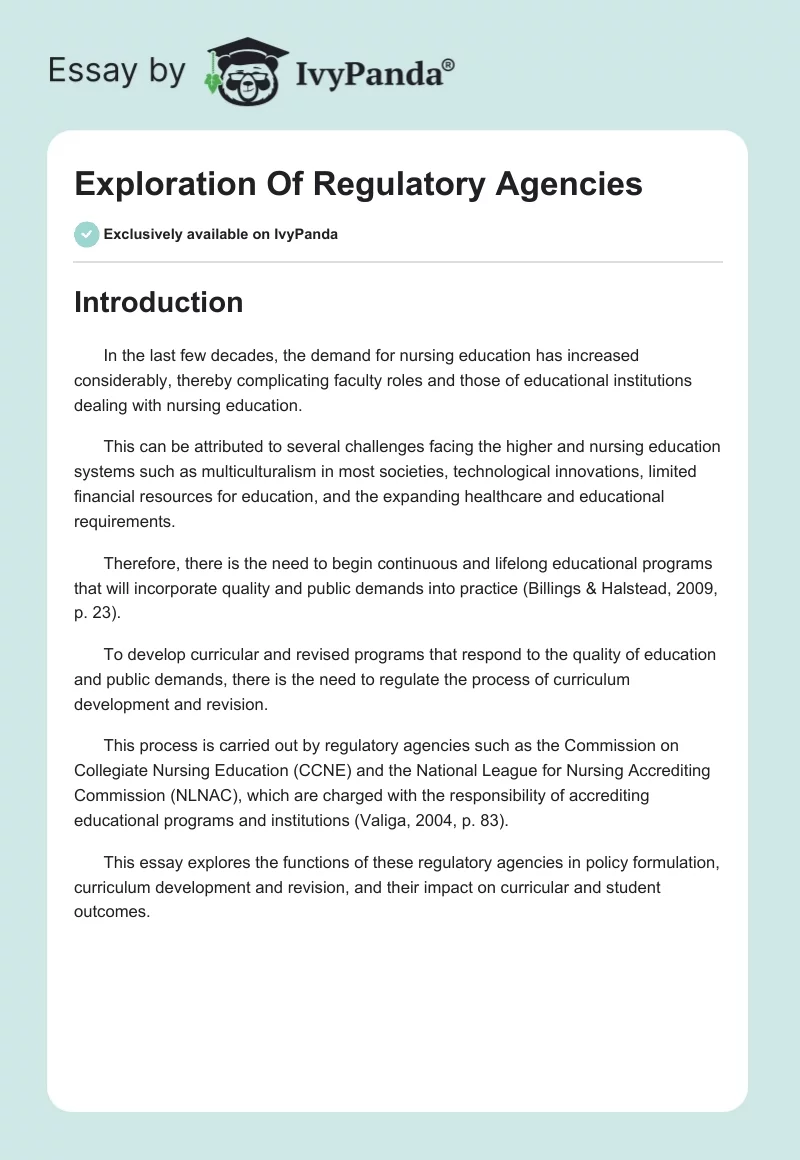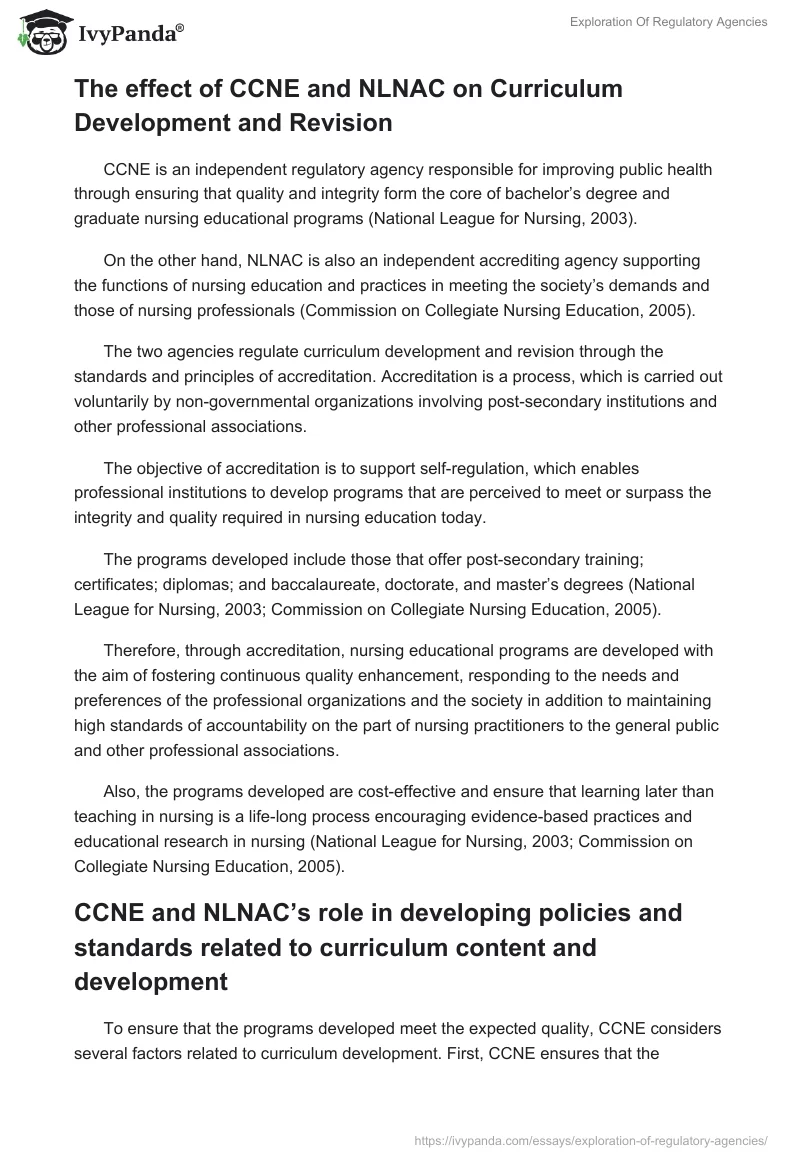Introduction
In the last few decades, the demand for nursing education has increased considerably, thereby complicating faculty roles and those of educational institutions dealing with nursing education.
This can be attributed to several challenges facing the higher and nursing education systems such as multiculturalism in most societies, technological innovations, limited financial resources for education, and the expanding healthcare and educational requirements.
Therefore, there is the need to begin continuous and lifelong educational programs that will incorporate quality and public demands into practice (Billings & Halstead, 2009, p. 23).
To develop curricular and revised programs that respond to the quality of education and public demands, there is the need to regulate the process of curriculum development and revision.
This process is carried out by regulatory agencies such as the Commission on Collegiate Nursing Education (CCNE) and the National League for Nursing Accrediting Commission (NLNAC), which are charged with the responsibility of accrediting educational programs and institutions (Valiga, 2004, p. 83).
This essay explores the functions of these regulatory agencies in policy formulation, curriculum development and revision, and their impact on curricular and student outcomes.
The effect of CCNE and NLNAC on Curriculum Development and Revision
CCNE is an independent regulatory agency responsible for improving public health through ensuring that quality and integrity form the core of bachelor’s degree and graduate nursing educational programs (National League for Nursing, 2003).
On the other hand, NLNAC is also an independent accrediting agency supporting the functions of nursing education and practices in meeting the society’s demands and those of nursing professionals (Commission on Collegiate Nursing Education, 2005).
The two agencies regulate curriculum development and revision through the standards and principles of accreditation. Accreditation is a process, which is carried out voluntarily by non-governmental organizations involving post-secondary institutions and other professional associations.
The objective of accreditation is to support self-regulation, which enables professional institutions to develop programs that are perceived to meet or surpass the integrity and quality required in nursing education today.
The programs developed include those that offer post-secondary training; certificates; diplomas; and baccalaureate, doctorate, and master’s degrees (National League for Nursing, 2003; Commission on Collegiate Nursing Education, 2005).
Therefore, through accreditation, nursing educational programs are developed with the aim of fostering continuous quality enhancement, responding to the needs and preferences of the professional organizations and the society in addition to maintaining high standards of accountability on the part of nursing practitioners to the general public and other professional associations.
Also, the programs developed are cost-effective and ensure that learning later than teaching in nursing is a life-long process encouraging evidence-based practices and educational research in nursing (National League for Nursing, 2003; Commission on Collegiate Nursing Education, 2005).
CCNE and NLNAC’s role in developing policies and standards related to curriculum content and development
To ensure that the programs developed meet the expected quality, CCNE considers several factors related to curriculum development. First, CCNE ensures that the objectives, governance and mission of the programs respond to the expectations of the professional institution and students being accredited.
Secondly, the agency ensures that the institution and students commit both human and material resources towards the continuity and improvement of developed programs.
Thirdly, the developed and implemented curricular must reflect the expected student outcomes by supporting effective teaching-learning exercises. Lastly, the agency ensures that the performance of accredited students and faculty reflects the purposes, tasks and the expected results of the curricular (National League for Nursing, 2003, p. 10).
On the other hand, NLNAC’s policies and standards for curriculum development are based on several ethical imperatives and guidelines that govern the accreditation process. First, NLNAC’s staff members eligible to join the accreditation team must meet the set regulations to avoid conflicts of interest. Secondly, the programs set to be accredited must demonstrate compliance with the expected goals, mission and outcomes.
Thirdly, the agency ensures that the members of the accreditation team employ the set standards and that they meet their responsibilities. Lastly, the agency puts in place several regulations defining the actions that can impair the accreditation process, which should be avoided by the accreditation team (Commission on Collegiate Nursing Education, 2005, p. 27).
Monitoring the effectiveness of Learning in the Accredited Curricular
Monitoring the learning process can be achieved through program evaluation. This process should involve evaluating the effectiveness of teaching, faculty roles, student outcomes, and curricular (Salsali, 2005). These factors are perceived to impact the learning process in many aspects.
Therefore, the teaching process should encourage student participation, whereby the educator’s role should be to facilitate the learning process later than acting as a knowledge source. On the other hand, the students should demonstrate the enthusiasm to inquire and explore new experience. Furthermore, the implemented programs and curricular should reflect the prevailing public and healthcare requirements (Salsali, 2005, p. 29).
In addition, diverse teaching, learning and evaluating practices should be developed to cater for the interests of a broader student population. These practices should also encourage active interactions involving students, faculty, alumni, and other professionals in the nursing profession. Lastly, the evaluation process should ensure that the teaching-learning practices are innovative and research-based (Valiga, 2004, p. 85).
The impact of Regulatory Agencies on Curriculum Development and Student Outcomes
From the discussions above, it is notable that CCNE and NLNAC exert a positive impact on curriculum development through establishing programs, institutional roles, faculty roles, and teaching-learning practices that encourage student participation, research, innovation, and evidence-based learning activities.
In this way, the accreditation process carried out by these agencies ensures that the student outcomes and nursing educational practices reflect the needs of the society and the nursing profession in general (National League for Nursing, 2003; Commission on Collegiate Nursing Education, 2005).
On the other hand, regulatory agencies ensure that the accredited programs encourage a life-long learning process that incorporates educational research and leadership in the nursing industry in addition to creating an environment that empowers accredited students and educators to explore new educational resources and experience.
Conclusion
This paper explores the functions and responsibilities of CCNE and NLNAC in curriculum development and revision through the process of accreditation. In addition, the paper describes the process of setting up policies and standards related to the content of curricular in the two regulatory agencies.
From the discussions above, it is notable that to encourage quality in nursing education, there is the need to monitor the effectiveness of learning in the accredited curricular. This is achievable through evaluating the effectiveness of teaching, the student outcomes, faculty roles, and the curricular in general. Lastly, the paper explains the impact of regulatory agencies on curriculum development and student outcomes.
Reference List
Billlings, D. M., & Halstead, J. A. (2009). Teaching in Nursing (3rd ed.). Philadelphia, PA: W. B. Saunders.
Commission on Collegiate Nursing Education. (2005). Proposed standards for accreditation of Baccalaureate and Graduate nursing programs. New York: American Association of Colleges of Nursing.
National League for Nursing. (2003). Innovation in Nursing Education: A Call to Reform [Position Statement]. New York: National League for Nursing.
Salsali, M. (2005). Evaluating teaching effectiveness in nursing education: An Iranian perspective. BMC Medical Education, 5(1), 29-35.
Valiga, T. M. (2004). Leadership for the future. Holistic Nursing Practice, 9(1), 83-90.


